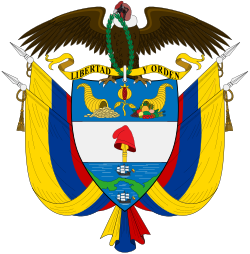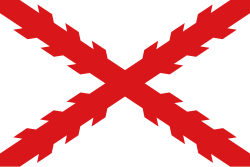Viceroyalty of New Granada
Viceroyalty of New Granada Virreinato de la Nueva Granada Virreinato del Nuevo Reyno de Granada | |
|---|---|
| 1717–1723 1739–1810 1816–1822 | |
| Motto: Utraque Unum "Out of two (worlds) one" | |
| Anthem: Ferdinand VII | |
Viceroy | |
• 1718–1719 (first) | Antonio Ignacio de la Pedrosa y Guerrero |
• 1819–1822 (last) | Juan de la Cruz Mourgeón |
| Historical era | Spanish colonization of the Americas |
• Established | 27 May 1717–1723 1739–1810 1816 |
• Suppressed | 5 November 1723 |
• Reestablished | 20 August 1739 |
| 8 September 1777 | |
| 20 July 1810 | |
| 3 September 1816 | |
| 24 May 1822 | |
| Population | |
• 1778[4] | 1,280,000 |
• 1810[5] | 2,150,000 |
| Currency | Spanish real |
The Viceroyalty of the New Kingdom of Granada (Spanish: Virreinato del Nuevo Reino de Granada
Colonial history

Two centuries after the establishment of the
The rough and diverse geography of northern South America and the limited range of proper roads made travel and communications within the viceroyalty difficult. The establishment of an autonomous Captaincy General in Caracas in 1777 and the preservation of the older Audiencia of Quito, nominally subject to the Viceroy but for most purposes independent, was a response to the necessities of effectively governing the peripheral regions. Some analysts also consider that these measures reflected a degree of local traditions that eventually contributed to the differing political and national differences among these territories once they became independent in the nineteenth century and which the unifying efforts of Simón Bolívar could not overcome.
Guajira rebellion

The Spanish had never subjugated the
In 1769 the Spanish took 22 Wayuus captive, in order to put them to work building the fortifications of Cartagena. The reaction of the Wayuus was unexpected. On 2 May 1769, at El Rincón, near Riohacha, they set their village afire, burning the church and two Spaniards who had taken refuge in it. They also captured the priest. The Spanish immediately dispatched an expedition from El Rincón to capture the Wayuus. At the head of this force was José Antonio de Sierra, a mestizo who had also headed the party that had taken the 22 Guajiro captives. The Guajiros recognized him and forced his party to take refuge in the house of the curate, which they then set afire. Sierra and eight of his men were killed.[8]
This success was soon known in other Guajiro areas, and more men joined the revolt. According to
| History of Colombia | ||
|---|---|---|
 | ||
| Timeline | ||
|
||
|
| ||
Administrative divisions
New Kingdom of Granada (Real Audiencia of Santa Fe de Bogotá)
The
- Province of Santa Fe (1717 to 1723, 1739 to 1810 and 1816 to 1819) (seat of the Real Audiencia)
- Province of Antioquia (1717 to 1723, 1739 to 1810 and 1816 to 1819)
- Province of Cartagena de Indias (1717 to 1723, 1739 to 1810 and 1816 to 1819)
- Province of Casanare (1717 to 1723, 1739 to 1810 and 1816 to 1819)
- Province of Mariquita(1717 to 1723, 1739 to 1810 and 1816 to 1819)
- Province of Neiva (1717 to 1723, 1739 to 1810 and 1816 to 1819)
- Province of New Pamplona (1717 to 1723, 1739 to 1810 and 1816 to 1819)
- Province of Santa Marta(1717 to 1723 and 1739 to 1821)
- Province of Tunja (1717 to 1723, 1739 to 1810 and 1816 to 1819)
- Province of Chocó (1726 to 1810 and 1816 to 1819)
- Province of Trinidad (1739 to 1777)
- Province of Darién (1751 to 1821)
- Province of Panama (1751 to 1821)
- Province of Portobelo(1751 to 1821)
- Province of Veraguas(1751 to 1821)
- Province of Socorro (from 1795 to 1810 and from 1816 to 1819)

Kingdom of Quito (Real Audiencia of Quito)
- Province of Quito (1717 to 1723 and 1739 to 1822)
- Province of Jaén de Bracamoros (1717 to 1723 and 1739 to 1821)
- Province of Macas (1717 to 1723 and 1739 to 1821)
- Province of Maynas (1717 to 1723 and 1739 to 1802)
- Province of Popayán (1717 to 1723 and 1739 to 1821)
- Province of Quijos (1717 to 1723 and 1739 to 1802)
- Province of Cuenca (1763 to 1822)
- Province of Guayaquil (1763 to 1803)
Kingdom of Tierra Firme (Real Audiencia of Panama)
- Province of Panama (1739 to 1751)
- Province of Darién (1739 to 1751)
- Province of Portobelo(1739 to 1751)
- Province of Veraguas(1739 to 1751)
Kingdom and Captaincy General of Venezuela (Real Audiencia of Caracas)
- Province of Caracas(1786 to 1810)
- Province of Barinas (1786 to 1810)
- Province of Guayana (1786 to 1810)
- Province of New Andalusia (1786 to 1810)
- Province of Maracaibo (1786 to 1810)
- Province of Margarita (1786 to 1810)
- Province of Trinidad(1786 to 1802)
Independent history
The retribution stoked renewed rebellion, which, combined with a weakened Spain, made possible a successful independence struggle led mainly by Simón Bolívar and Francisco de Paula Santander in neighboring Venezuela. Bolívar returned to New Granada only in 1819 after establishing himself as leader of the pro-independence forces in the Venezuelan llanos. From there Bolivar led an army over the Andes and captured New Granada after a quick campaign that ended at the Battle of Boyacá, on 7 August 1819, finally proclaimed independence in 1821. The pro-Spanish resistance was defeated in 1822 in the present territory of Colombia and in 1823 in Venezuela.
The territories of the viceroyalty gained full de facto independence from Spain between 1819 and 1822 after a series of military and political struggles, uniting in a republic now known as Gran Colombia.
With the dissolution of Gran Colombia, the states of Ecuador, Venezuela, and the Republic of New Granada were created. The Republic of New Granada, with its capital at Bogotá, lasted from 1831 to 1856. The name "Colombia" reappeared in the "United States of Colombia"; the new name for the country having been introduced by a liberal government after a civil war. The use of the term "New Granada" survived in conservative circles, such as among ecclesiastics.
Demographics
In the 1778 census, New Granada had a population of around 1,280,000, around 40% of the population being Indians with around 500,000 people, with the next largest group being free Mestizos and Africans at around 400,000, then Whites with close to 300,000, and the smallest group at around 70,000 people being slaves.[4] However, in the current territory of Colombia, it was estimated that the population was 826,550.[9] New Granada was estimated to have 2,150,000 inhabitants in 1810.[5]
See also
- History of the Americas
- History of Colombia
- History of Ecuador
- History of Venezuela
- List of Viceroys of New Granada
- Spanish Empire
- Criollo people
Notes
- ^ Callao-Lima, Peru. United States. Bureau of Naval Personnel. 1920. p. 26.
- ^ Lawrence, Sondhaus (2012). Naval Warfare, 1815–1914. p. 13.
- ^ Von Tschudi, Johann (1847). Travels in Peru. p. 33.
- ^ a b "New Granada, Viceroyalty of". www.encyclopedia.com. Retrieved 17 August 2024.
- ^ a b Codazzi, Agustín; Paz, Manuel María; Pérez, Felipe. Atlas geográfico e histórico de la República de Colombia.
- ^ "El archipiélago de Los Monjes y las relaciones diplomáticas con Venezuela: Historia de una cesión territorial cuyas consecuencias siguen vigentes". banrep.gov.co.
- ^ (in Spanish) Diccionario de Historia de Venezuela. Caracas: Fundación Polar, 1997.
- ^ a b c "La rebelión Guajira de 1769 : algunas constantes de la Cultura Wayuu y razones de su pervivencia – banrepcultural.org". banrep.gov.co.
- ^ "Censo cuenta 826.550 habitantes en la Nueva Granada" [Census counts 826,550 inhabitants in New Granada]. www.banrepcultural.org (in Spanish). Archived from the original on 24 December 2013.
Bibliography
- Fisher, John R., Allan J. Keuthe and Anthony McFarlane, eds. Reform and Insurrection in Bourbon New Granada and Peru. Baton Rouge, Louisiana State University Press, 1990. ISBN 978-0-8071-1654-8
- ISBN 978-0-8130-0570-6
- McFarlane, Anthony. Colombia Before Independence: Economy, Society, and Politics under Bourbon Rule. Cambridge, Cambridge University Press, 1993. ISBN 978-0-521-41641-2
- Phelan, John Leddy. The People and the King: The Comunero Revolution in Colombia, 1781. Madison, University of Wisconsin Press, 1978. ISBN 978-0-299-07290-2
- Torres, James. "Bullion and Monetary Flows in the Northern Andes: New Evidence and Insights". Revista Tiempo y Economia 6(1), 13–46,
External links
Viceroyalty of New Granada
(Virreinato de Nueva Granada).



